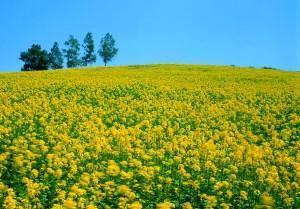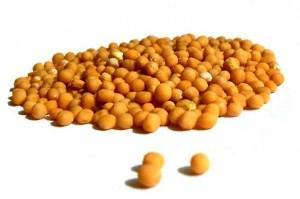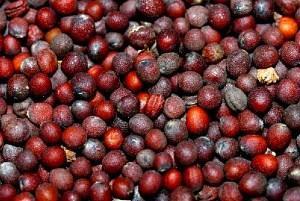Mustard - as fertilizer for the soil
 The soil is fertilized not only with chemical, but also natural means - dung, onion husks, tobacco, herbs, egg shells and others. However, the soil can be fertilized in another way. For example, by planting mustard. It is rarely used as a fertilizer. It is commonly used in cooking and medicine. But it is worth paying attention to this plant and gardeners who want to fertilize the soil on their land.
The soil is fertilized not only with chemical, but also natural means - dung, onion husks, tobacco, herbs, egg shells and others. However, the soil can be fertilized in another way. For example, by planting mustard. It is rarely used as a fertilizer. It is commonly used in cooking and medicine. But it is worth paying attention to this plant and gardeners who want to fertilize the soil on their land.
Differences between white mustard and sarepta
There are two types of mustard:
- As fertilizer for the garden. Other types are not used for this purpose. But white mustard as a fertilizer is very good. It is also called English.
- The second type is Sarepta or gray mustard, many people know it as Russian.
These two types of green fertilizers differ in a number of ways:

 White mustard seeds germinate at a temperature of one to two degrees Celsius. For gray mustard, a slightly higher temperature is required - from two to four degrees with a plus sign. English white mustard is more resistant to cold and even tolerates small frosts - up to minus six degrees. The Russian, despite the name, is sensitive to cold weather. Three degrees above zero can be fatal for her. The growing season of white mustard is about 60-70 days. In gray mustard, this period is longer - it reaches one hundred days. Moreover, the farther north, the shorter the growing season.
White mustard seeds germinate at a temperature of one to two degrees Celsius. For gray mustard, a slightly higher temperature is required - from two to four degrees with a plus sign. English white mustard is more resistant to cold and even tolerates small frosts - up to minus six degrees. The Russian, despite the name, is sensitive to cold weather. Three degrees above zero can be fatal for her. The growing season of white mustard is about 60-70 days. In gray mustard, this period is longer - it reaches one hundred days. Moreover, the farther north, the shorter the growing season.
The height of white, English mustard before flowering is from half a meter to seventy centimeters. Then it grows another 20-30 centimeters and can reach more than a meter in height. If the soils are poor and sandy, the plants will be lower. Russian mustard is slightly higher than its English “relative”. Both types of mustard differ in their seeds. In white mustard, they are spherical and slightly yellowish in color. The mass of a thousand seeds is about six grams. Russian mustard seeds are oval, gray-black or yellow. Their mass is from two to four grams (1000 pieces).
Advantages and disadvantages
Mustard not only fertilizes the soil, but also performs other useful functions. She:
- relieves the garden of weeds, especially on cultivated land. This is because the mustard itself grows rapidly;
- has good phytosanitary properties, combats pests such as slugs, pea moth and wireworm;
- helps to fight plant diseases - late blight and potato scab. This effect is achieved due to the fact that mustard binds iron in the soil and thus heals it;
- mustard has a large biomass, which means it replenishes the soil with important organic substances. Subsequently, they are processed into humus;
- fertilizing the soil with mustard makes the soil looser and structured thanks to the roots reaching three meters. The soil absorbs more moisture and air;
- mustard helps to retain nitrogen in the soil, thereby preventing it from leaching. But this crop, unlike legumes, only holds nitrogen, and does not convert it into a form suitable for other plants;
- this green manure converts the substances contained in the soil into organic form and they do not go deep;
- when frosts come and snow falls, mustard falls on the ground, protecting it from freezing;
- mustard is an excellent honey plant, and many insects that pollinate plants rush to it;
- use mustard also as a companion. It improves the growth of some fruit trees, grapes and beans. If mustard is planted for this purpose, then very few seeds need to be taken. But for growing as a green manure, the number of seeds should be significantly larger;
- mustard is also good as a precursor for potatoes, tomatoes and some other crops, since it fights plant diseases.
Below we will tell you how and when to sow mustard, but first you need to say about its disadvantages:
- Mustard, like other cruciferous vegetables, can suffer from diseases and harmful insects. For this reason, it is important to consider the rules of crop rotation when planting it;
- some birds love mustard. If this worries the grower, he needs to cover the seeds after sowing with mulch.
Features of sowing mustard for soil fertilization
 Mustard should be planted on sod-podzolic, fertilized soil. Sandy loam soil cultivated with peat is also suitable for this plant. But clayey, acidic soils and salt marshes are not suitable for mustard. When sowing mustard to fertilize the soil, remember that this plant does not like drought and requires frequent watering during bud formation. No need to use mustard as a precursor cabbagebecause they have common diseases.
Mustard should be planted on sod-podzolic, fertilized soil. Sandy loam soil cultivated with peat is also suitable for this plant. But clayey, acidic soils and salt marshes are not suitable for mustard. When sowing mustard to fertilize the soil, remember that this plant does not like drought and requires frequent watering during bud formation. No need to use mustard as a precursor cabbagebecause they have common diseases.
White mustard can be sown from early spring to early autumn, allotting any free area to it. The best time in spring is 30 days before planting vegetables. Mustard is sown as a fertilizer in the fall immediately after harvest, while there is still shadow moisture in the soil. You can plant seeds to a depth of one and a half to two centimeters, leaving a distance of 15 centimeters between them. In this case, the consumption of seeds will be about 150 grams per hundred square meters or slightly less.
 Another method is scattering seeds on the beds, further harrowing with a rake and sprinkling with earth. When mustard is planted to fertilize the soil in the second way, it must be borne in mind that the consumption of seeds is at least twice as large. The first shoots will appear in three to four days. In five to six weeks, the plant will grow to twenty centimeters and will need to be mown. The resulting mass must be crushed and embedded in the ground, watering with EM means, such as "Shining" and others. Next, cover with roofing felt or a dark film.
Another method is scattering seeds on the beds, further harrowing with a rake and sprinkling with earth. When mustard is planted to fertilize the soil in the second way, it must be borne in mind that the consumption of seeds is at least twice as large. The first shoots will appear in three to four days. In five to six weeks, the plant will grow to twenty centimeters and will need to be mown. The resulting mass must be crushed and embedded in the ground, watering with EM means, such as "Shining" and others. Next, cover with roofing felt or a dark film.
If this is your first time sowing this plant, it is worth seeing how mustard is planted for fertilization. Videos on this topic can be found on the Internet. It is worth emphasizing again that mustard loves moisture, so it must be watered frequently. This is especially important when natural precipitation in the form of rain is absent for a long time. Taking care of mustard in this way will help to ensure that the soil in the garden will be loose, rich and healthy. If the mustard is grown for honey collection, the number of seeds must be reduced and the plants must be sown at a greater distance from each other.
You can collect your own seeds if you wish. To get seeds, you need to sow mustard in the spring, and not very densely. With summer sowing, seeds cannot be obtained. English mustard pods do not crack, so they can be harvested during the day and evening. Russian mustard, on the other hand, has more fragile pods, so its seeds must be harvested early in the morning or late at night.
Thanks to the author for a very relevant and interesting article. I have never heard of such beneficial properties of the mustard plant before. I will definitely try to plant half of the garden with mustard this year.It may help a little to cope with weeds, wireworms, and the prevention of late blight will not hurt. Who has tried this method? What's the result? Write please.